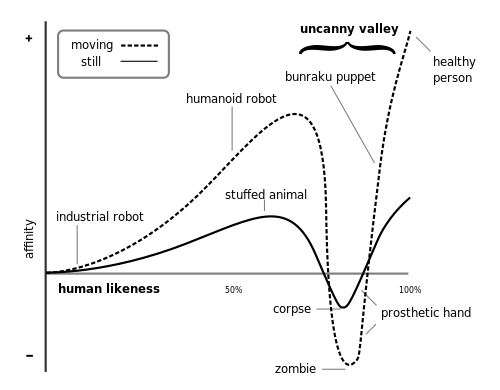From Digital Trends
Were you creeped out by the characters in Polar Express? Do you find clowns, human puppets, and overly-realistic robots to be unsettling? How about the too-close-to-human robotic Hiroshi Ishiguro (see image on left)? The term "Uncanny Valley" has been used to describe the unease people feel as inanimate objects become closer and closer to human in appearance. On the one side of the valley, Kermit the Frog and R2D2 are fine. At the opposite side we have the sexy Cylons in the remade Battlestar Galactica. No problem with any of them. But somewhere in the middle we hit the almost-but-not-quite-human animations and robots that seem to make us squirm. Now scientists may have uncovered the mechanism behind this dissonance.
Were you creeped out by the characters in Polar Express? Do you find clowns, human puppets, and overly-realistic robots to be unsettling? How about the too-close-to-human robotic Hiroshi Ishiguro (see image on left)? The term "Uncanny Valley" has been used to describe the unease people feel as inanimate objects become closer and closer to human in appearance. On the one side of the valley, Kermit the Frog and R2D2 are fine. At the opposite side we have the sexy Cylons in the remade Battlestar Galactica. No problem with any of them. But somewhere in the middle we hit the almost-but-not-quite-human animations and robots that seem to make us squirm. Now scientists may have uncovered the mechanism behind this dissonance.
 |
| Image Source: Wikimedia Commons |
"Researchers from the university of California, San Diego, have discovered that a mismatch between movement and humanoid traits could be causing the uncanny valley effect, or the uneasiness we feel when we look at humanoid robots or CGI creations."
"Unfortunately, we still don’t entirely know why our brain hates this inconsistency, but if movies and video games are any indication, our brains may be able to get used to the oddness of our human-like creations in time. Games like L.A. Noire have found success by somewhat reducing the uncanny valley effect by drastically improving the facial and body animation of its characters. Faster animation in motion-capture CGI films like the upcoming Spielberg film The Adventures of Tintin are also working around this odd phenomenon. Unfortunately, we don’t quite know if our brains will ever truly accept fake humanoids until they are completely indistinguishable from ourselves."

No comments:
Post a Comment